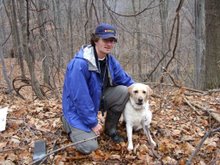Heart study #2
This morning I headed over to uOttawa for the second part of the heart rate study, the VO2 test on a treadmill. After doing a warmup on the treadmill and then some stretching, it was time for the fun to begin. There are a couple of ways to conduct the test, one ways is to incrementally speed up the treadmill until you can no longer run as fast as the treadmill is spinning and the second, is to keep the treadmill spinning at a constant rate and gradually increase the grade angle. For this test they opted for later and it simulates hill climbing. The test started off well as the angle of the treadmill was adjusted every minute but then something bad happened. I started to sweat and nose clip started to slide off. When the clip was on we were starting to get a VO2 value in the low 50s with the expectation that my final VO2 would be in the mid 60s which is similar what I had done a couple of years ago. The researcher decide because the results were coming out so inconsistent to pull the test. I was having a good time and as I was getting into the "groove"/"zone" and my legs still felt fresh.
The plan is to re-do the research early next week and with the hope that they can locate a non-defective nose clip.

